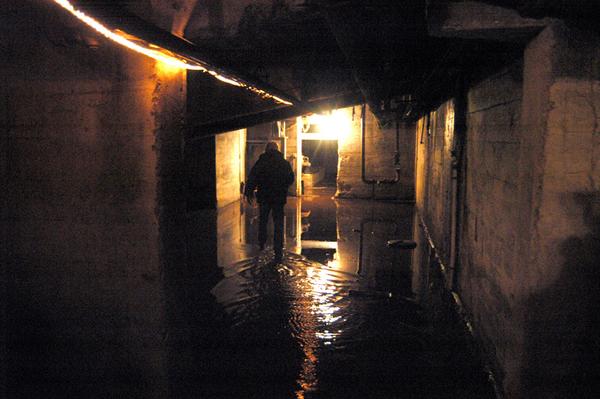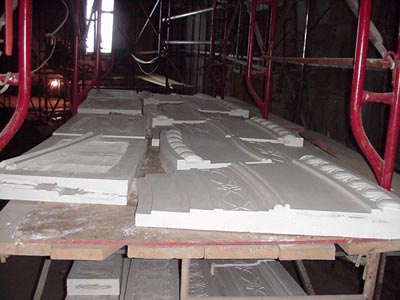


Crosby said nearly a year ago that the state had promised $250,000 for Columbia renovations,
with another quarter-million available if the hall could match the money.
Even then, Sharon Mayor Bob Lucas and a spokesman for Gov. Edward Rendell
called the announcement premature.
“The governor likes to make those announcements,”
Lucas said last week, and no announcement has been made.
“We kind of pulled back from that because we have this large project going on,” Lucas said.
The large project is a $24 million, five-year effort to revitalize downtown Sharon,
centered on Shenango Avenue Associates’ plan to build an $8 million, eight-story,
mixed-use building at Pitt Street and Shenango Avenue.
City officials hope the Shenango Avenue project can be used as a match to secure state and
federal funding for other projects, including a riverwalk, renovating the city’s parking garage,
a street extension, green spaces and renovation money for the Columbia, Lucas said.
The hall also has been put on the list for $5 million in Regional Capital Assistance Grant money,
which is state money funded by a bond issue for economic development projects.
The program has no money, but Rendell wants to increase the program’s cap to generate
new funds, Longietti said, adding that some Republican officials oppose the proposal.
Longietti, who served on the Save the Columbia Theatre Committee that existed before
Tony Butala bought the theater for the hall of fame, said he recently toured a theater in Easton, Pa.,
that has become an economic force in an area that is roughly the same size as the Shenango Valley.
“They’re holding 120 shows a year and have a very active community theater,” Longietti said. “I think what they’re doing could be a model for what they’re (Crosby and Butala) doing in Sharon.”
Even if any of these proposals come to fruition, they do not meet Crosby’s current needs. He has been relying on weekly help from residents of Sharon Community Corrections, a halfway
house, to remove debris, paint and put up dry wall at the Columbia and the Phoenix building.
What he needs are electricians and plumbers.
“We’re limited to things that can only be done without money,” Crosby said.
He said he had hoped local tradesmen would step in and complete specific tasks,
such as a bathroom, but that has not happened.
So, Crosby keeps plugging away.“We think we’re doing the right things, but it’s progressing at a snail’s pace most of the time.
We’re proud that we’re doing it despite the obstacles. There’s nothing else to do.”
A licensing agreement with public television stations has heightened
the Vocal Group Hall of Fame’s visibility nationally. The hall’s Web site, www.vocalgroup.org, gets more than half a million hits a month,
and officials receive e-mails
asking when the next induction ceremony will be and
the museum will be open.
“These are very, very good, signs,” said hall President Bob Crosby,
who has volunteered his services
to the hall for six years.Unfortunately, Crosby is not a magician. He can’t turn good signs into bricks and mortar.
He has made some progress in renovating the Columbia Theatre and the former Phoenix building where the hall of fame, a piano bar, a banquet facility and offices would be located
but concerts and museum exhibits still are a long way off.
The public television deal — in which hall merchandise is used for pledge drives
has brought in new dollars, but they get eaten up in the $10,000-a-month expenses associated
with the buildings,
including mortgages and utilities.“It’s not enough,” Crosby said.
If he could get the buildings open, he could generate revenue, Crosby said.
He can’t get the buildings open without revenue. If the vocal hall had a theme song, it’s title would be “Catch-22.”
If only the hall’s building activities could mirror the success of the Truth in Music effort.
Headed by Jon “Bowzer” Bauman, the Truth in Music Committee has secured laws aimed at outlawinggroups that pass themselves off as the originals in 18 states,
with legislation pending in another 12, including Ohio.“We’re doing really fantastic with Truth in Music,” Crosby said.
The hall hopes to celebrate its 10th anniversary this year with a five-day induction ceremony that would honor the classes of inductees from 2005, 2006 and 2007. Plans are to keep the event local the last ceremony, in 2004, was held in Wildwood, N.J.
but no dates and places have been firmed up.
Again, the problem is money. Crosby said he needs $200,000 to $250,000 for inductions.
The state appears to be ready to pony up $50,000, Crosby said,
but this allocation has been pending for more than a year.
The Shenango Valley Foundation is willing to front the money and be repaid by the grant,
when it is released, and the Mercer County Convention and Visitors Bureau would
grant another $50,000, Crosby said.
State Rep. Mark Longietti, D-7th District, Hermitage said he’s been assured by state officials
the hall will get $25,000 soon, with another $25,000 coming from the next budget cycle.
That leaves the hall $100,000 to $150,000 short. Officials could press on and hope to recoup
the remaining funds through the induction concerts and other activities,
but the hall could stand to owe whatever it cannot raise. Officials still are paying off the 2003 inductions.
If the hall could get the money for inductions paid up front, then it could use gate receipts
from tickets sales at the induction concerts for whatever officials please, such as renovating its buildings.
By Joe Pinchot
Herald Staff Writer
SHARON —
By 1933, the Theatre operated a split week policy: part of the week was devoted to first run movies and part to vaudeville shows. This continued into the 1940's when the theatre was aquired by Warner Brothers and into the 50s as it changed hands once again. By the 1960s however, motion pictures had replaced live programming and the theatre began to feel financial pressure from the suburban multiplex cinemas.
During the mid-1980s several renovation projects were undertaken which stabilized the facility but did not replace the building or theatrical systems. Projects continued through the late 1980s and into the early 1990s as the funding and need presented themselves. Although the facility as it exsists has cosmetic deficiencies, the Columbia Theatre was built of steel and concrete and remains structurally sound, retaining the basic elements
of heronce elegant interior.

